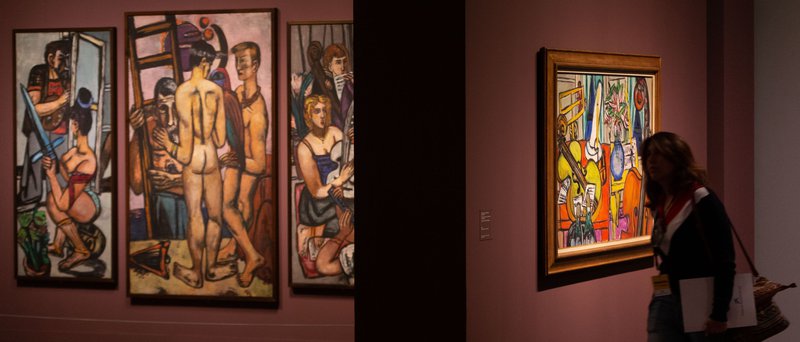The German Picasso
For the first time, CaixaForum in Barcelona displays around 50 works by the German painter Max Beckmann, a sensitive soul who suffered the tumultuous 20th century and was chased out of his country by the Nazis
“He represents the 20th-century spirit better than Picasso” The menace of the Nazi regime did not repress him as an artist
The German artist Max Beckmann finished his last work the same day he died, in New York in 1950, at 66 years of age . He had spent two years on it, as he wrote in his diary, and finished it just before he left his house to see one of his paintings on show at the Metropolitan. But he didn’t get there. Halfway there, he had a heart attack. Beckmann had only spent three years in the US, but he had been in exile from Germany for a long time before that, sick of the new cultural order imposed by the Nazis. His modernity meant he had been excluded.
Argonauten, the piece that he was miraculously able to finish before unexpectedly leaving this world, ends the exhibition dedicated to the German artist at the CaixaForum, organised in conjunction with the Thyssen Museum in Madrid. The show runs until May 26, and has 49 of the relatively few 200 works that Beckmann produced throughout his life. According to the curator, Tomàs Llorens, “Beckmann represents the spirit of the 20th century better than Picasso: tough, innovative, exciting and at the same time dramatic and terrible.” Picasso, who in addition to his talent was sharp, also realised Beckmann’s gifts in a show in Paris in 1931: “He is very strong,” he said about him. In the capital of France, which for a while, was the world capital of art, Beckmann was known as “the Germanic Picasso”.
Down to earth
Beckmann was born into a middle class family in Leipzig in 1884. In 1904, he settled in Berlin and soon stood out with his own new way of understanding art rooted in reality. “Reality is what makes the mystery essential to the human being,” he would say. Beckmann’s first priority was “being objective” and he declared himself an enemy of any idealised visions: “There is nothing I hate more than sentimentalism,” he said.
At the outbreak of the First World War, he decided to volunteer as an orderly in the army. He wasn’t the only artist to go to the front. According to Tomàs Llorens, “he didn’t do it so much out of patriotism, but to look for the life experience of war in itself.” But he didn’t last even a year in the army. He had such a huge breakdown that he was given sick leave. From the letters he sent to his first wife, it is clear how sensitive he was: “It is a wild, curious life that I am living. I have never seen the indescribable absurdity of life revealed in such an obvious way.“
Once the Great War was over, he defended his artistic project in the confused Germany between the wars. And he did so very well. He was understood. Even though his paintings would bear the mark of expressionism, he rejected labels and belonging to any movement or trend. And it worked for him: he had frequent exhibitions, and museums would buy his works. He then created some of his masterpieces, such as Paris Society (1931) – an apparently festive work, but with a detail that cannot pass unnoticed: all the characters, elegant as they were, have troubled faces and vacant smiles, as if they could foresee the disaster about to hit so soon.
Two years later, Hitler came to power. Beckmman wasn’t a Jew, but he had been related to the cultural elites of the people about to be destroyed. His art was soon rooted out by the regime, his reputation disappeared, and he became invisible. In 1937, his works were put on display at the famous show of degenerate art in Munich, the Nazi manifesto aimed at stigmatising modern art.
The same year, he went into exile in Amsterdam, where he lived in an almost clandestine way until the end of the war. But he couldn’t be repressed as an artist. In the splendid Landscape with Baloon, he cruelly recreates the torture and assassination of the Dutch resistance by the German army.
feature art
Seeing and feeling
He not only painted what he saw, but what he felt. Expelled from his country, he knew his destiny would be to wander the world. In the triptych Carnival (1943), and later in New York, in Mascarade (1948), he portrayed himself and his wife Mathilde, known as Quappi, with bitter disguises. Mascarade took on a fatalistic symbolism at the end of his career. Feelings of impotence and frustration also impregnated his sea paintings, like the sea that swallows the Falling Man. It is a major work that, like The Argonauts (another agitated sea), he created, before his heart finally said “enough”.

